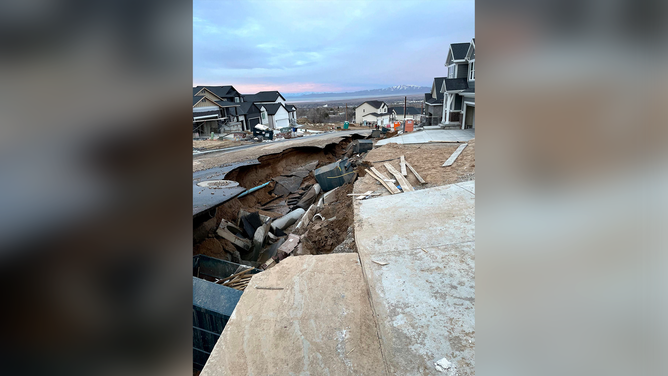Prolonged flooding threat expected in the Upper Midwest, West with spring snowmelt season underway
The spring snowmelt happens every year when temperatures gradually warm above freezing consistently enough to melt snow that has stuck around in regions all winter.
Spring snowmelt could lead to prolonged flooding in Upper Midwest, Rockies
The spring snowmelt happens every year when temperatures gradually warm above freezing consistently enough to melt snow that has stuck around in regions all winter. That resulting water that has been stored will be released, which can lead to the ponding of water on roadways, as well as rises in rivers and streams.
Nearly 200 million Americans from the Southwest to the Northeast have been enjoying a brief taste of summer with dozens of record-high temperatures broken across the U.S. However, that warmup has kick-started the spring snowmelt season leading to a flooding threat that could last for weeks.
The spring snowmelt occurs every year when temperatures gradually begin to warm above freezing consistently enough to melt the snow that has stuck around during winter.
The resulting water that has been stored is then released, leading to ponding on the roadways and rises in rivers and streams.

(FOX Weather)
"Just a matter of weeks ago, we were talking about feet of snow across the Dakotas," FOX Weather meteorologist Britta Merwin said. "Well, now we’ve had temperatures pushing 90 degrees. That combo can be dangerous when it comes to snowmelt."
It’s been an extreme snow season in the northern Plains, the Upper Midwest, the Rockies, and the Sierra Nevada in the western U.S.
"We knew that the snowmelt is going to be impressive as we move into the spring season," Merwin added. "All of that water has to go somewhere. So, if you live to the west of the Continental Divide, of course, all of that water is going toward mainly the Pacific. But to the east, it’s going to be filtering right down in the Mississippi River Valley."

(FOX Weather)
Bismarck, North Dakota, has seen more than 50 inches over what is typically seen during the winter, so as all of that snow melts, the water will be moving into the rivers.
"Minneapolis is going to be an area where we do have to look out for major flooding," Merwin said. "All of this eventually is going to be dumping into the upper part of the Mississippi River, and it’s going to lead to some high water levels."

(FOX Weather)
Upper Midwest, Rockies flooding concerns
According to the FOX Forecast Center, areas that will be impacted are used to flooding during the spring, but after the record year of snowfall, the risk of flooding will be much higher than in previous years.
Timelapse captures March snowmelt in northern Wisconsin
Timelapse video captured snow melting through the month of March in Brule, Wisconsin. (Credit: @NWSDuluth/Twitter)
There are two main areas of concern – the Upper Midwest and the Rockies.
But as temperatures rise and snow melts, more regions will be at risk of flooding.

(FOX Weather)
Flood alerts have been issued in the northern Plains and Upper Midwest, and they will remain in effect until further notice.
Flood Warnings have been issued for areas of the Dakotas, Minnesota, Wisconsin and Michigan.
Flood Advisories are in effect in northern Minnesota and northwestern Wisconsin.
Utah flooding

Sections of roads were washed away in the city of Kaysville, Utah, after flooding from spring melting on Wednesday.
(L. Benson/Kaysville Fire Department)
Reports of flooding have been received in Utah, where the rising temperatures have been causing snow to melt.
Images from the city of Kaysville show roads that have been washed out due to the flooding, and officials said at least 25 homes in the Orchard Ridge area had been evacuated as a precaution.
Fire officials said they were alerted to the flooding just before midnight Wednesday. When they arrived at the scene in the northeastern part of the city, they saw homes threatened by the floodwaters and ordered evacuations.

A section of road was washed away in the city of Kaysville, Utah, after flooding on Wednesday.
(L. Benson/Kaysville Fire Department)
"The city is not in direct threat of significant flooding within city limits at this time," officials said in a statement. "Although localized instances of flooding may continue to occur, this incident appears, at first blush, to be the result of a blocked storm drainage system."
People are being asked to avoid the area.
Flooding concerns in California
Mountain snowmelt posing flooding and avalanche threat
As warmer temperatures are impacting millions of Americans this week, mountain snowmelt is beginning to pose a problem as runoff is causing flooding and avalanche concerns.
Flooding conditions will also be monitored closely in California.
"A lot of the dire situations are going to be associated with the Mississippi River watershed, but in California, what to watch is the San Joaquin Valley and Sacramento Valley very closely," FOX Weather meteorologist Britta Merwin said.
It’s been a record-breaking winter season for those regions, and that could mean trouble once that starts to melt.

(FOX Weather)
"The Sierra Nevada has had an epic snow year," Merwin added. "We’re talking about a snowpack 300%-400% of average. It’s the deepest snowpack we’ve ever had on record for the Sierra, which means that we’re going into uncharted territory."
Merwin said that once the snow melts, the water will flow into the valleys.
"Keep in mind, the peaks of the Sierra, they’re going up well above 8,000 feet," she said. "So, a lot of that water is going to be spilling back over to the west, into the Sacramento Valley and in the San Joaquin Valley."


